 Red Butte in Coconino County, Wednesday, Aug. 30. Known as "Wii'i Gdwiisa," in Havasupai, the sacred grounds are protected under President Joe Biden's Baaj Nwaavjo I'tah Kukveni- Ancestral Footprints of the Grand Canyon National Monument.
Red Butte in Coconino County, Wednesday, Aug. 30. Known as "Wii'i Gdwiisa," in Havasupai, the sacred grounds are protected under President Joe Biden's Baaj Nwaavjo I'tah Kukveni- Ancestral Footprints of the Grand Canyon National Monument.
Season 2 Episode 9: Havasupai

For people who visit or call Grand Canyon National Park home, the water issues mainly come around moving water up to the rim where the homes, hotels, and other businesses sit. But, head downstream to one of the most remote tribal nations in America, and the water issues are very different.
The Havasupai people's land sits in the canyon, surrounded on all sides by the park. They're not worried about pumping the water up. Their worries are about what trickles down. Upstream from them sits an area where uranium mining was once plentiful. And that atomic-age history is causing concerns about water quality.
This episode of Tapped was supported by a grant from The Water Desk, an independent journalism initiative based at the University of Colorado Boulder's Center for Environmental Journalism.
Episode transcription
Zac Ziegler: In August, President Joe Biden designated the Baaj Nwaavjo I’tah Kukveni- Ancestral Footprints of the Grand Canyon National Monument.
The designation provides some permanent safeguards for nearly one million acres of public land that surrounds the iconic national park, including the sacred ancestral land of the Havasupai Tribe, a people who are often described as the most remote tribe in America. That protection helps prevent any new mining claims in an area that has been the center of uranium production in the U-S for decades.
One of the tribe's most sacred sites is Red Butte, a thousand-foot tall formation that the Havasupai call their birthplace.
(theme music fades in)
But, just three miles away from Red Butte is Pinyon Plain Mine, a uranium mine owned and operated by Energy Fuels, Incorporated.
This is Tapped, a podcast about water. I’m Zac Ziegler.
The mine’s impact and proximity to Red Butte has been the epicenter of legal battles between the Havasupai people, and governmental agencies. And there's been a lot of fighting over how destructive uranium mining is to people in the region.
So what does it mean for a remote population’s water supply, when nearby there’s a mine centered on radioactive material?
(theme music fades out)
I'll hand things off to A-Z-P-M’s diversity, equity and inclusion reporter Paola Rodriguez and environmental reporter Katya Mendoza, who traveled to the National Monument and park to explore what this designation really means for the Havasupai people’s fight for sovereignty, if this mine remains.
Paola leads things off.
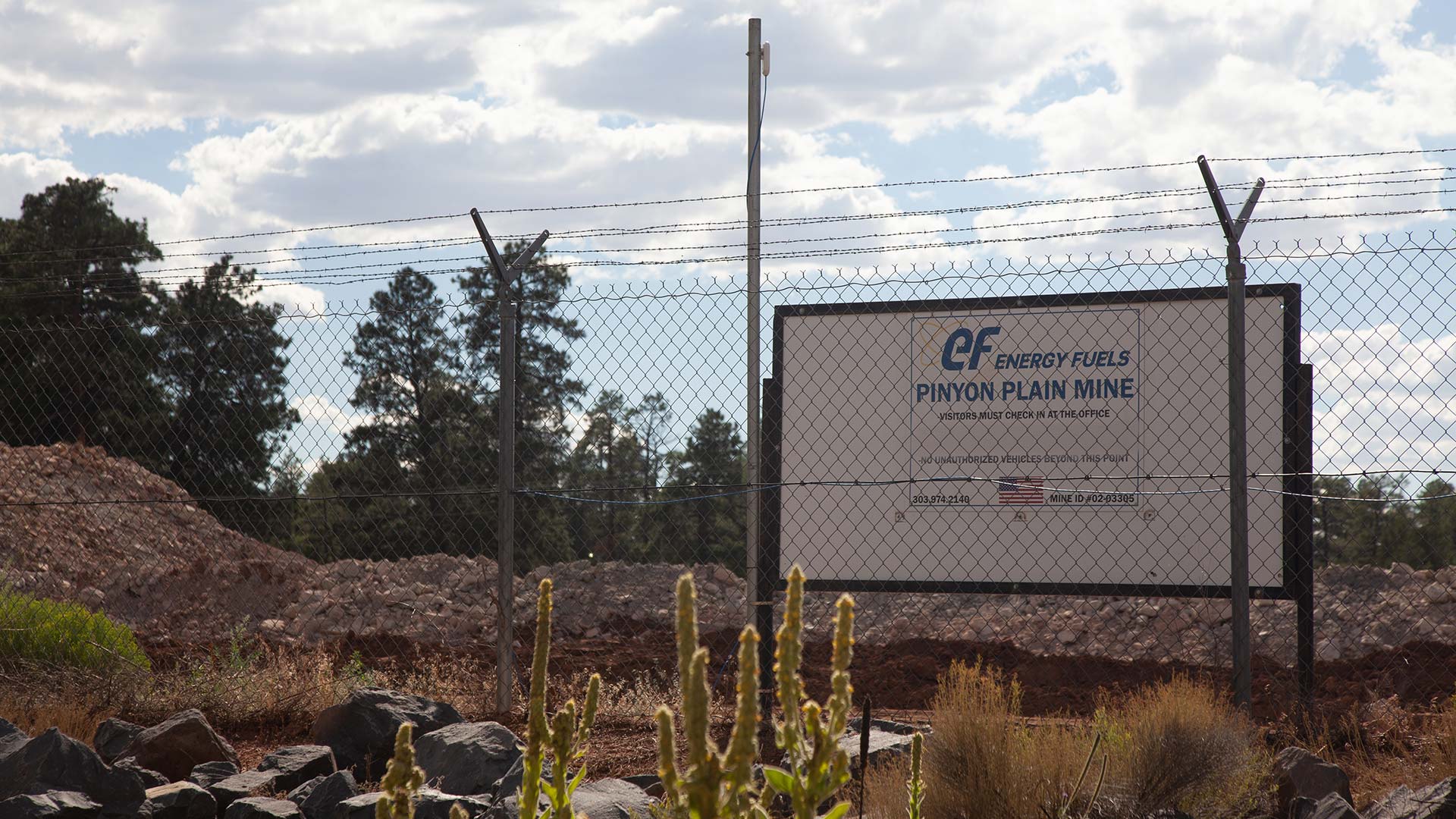 VIEW LARGER Pinyon Plain Mine in Coconino County, on Wednesday, Aug. 30. In 1984, Energy Fuels Nuclear Inc, proposed to recover a uranium ore deposit nine miles south of the Grand Canyon. Formerly known as Canyon Mine, Pinyon Plain mine has not mined uranium ore to this day, due to low commercial uranium prices.
VIEW LARGER Pinyon Plain Mine in Coconino County, on Wednesday, Aug. 30. In 1984, Energy Fuels Nuclear Inc, proposed to recover a uranium ore deposit nine miles south of the Grand Canyon. Formerly known as Canyon Mine, Pinyon Plain mine has not mined uranium ore to this day, due to low commercial uranium prices.
(natural sounds of hike starts)
Sound clip of Paola interviewing Katya:
Paola: Katya, can you tell us where we're at right now and kind of what we're seeing?
Katya: Sure. So right now we're on one of the switchbacks, I believe, almost a mile down of Bright Angel Trail here in Grand Canyon National Park.
Paola: And what are we doing here today at Grand Canyon National Park?
Katya: So we thought we would honor the area by doing a hike and we're feeling a little ambitious today. So we're gonna try to make it to Havasupai Gardens.
Paola: And can you tell us a little bit about the history of the Grand Canyon and how the Havasupai people, you know, how they inhabited this area before and what came about?
Katya: Sure, so since time immemorial, the Havasupai people and other tribes used to freely roam this area. And up until I want to say the early 1900s the United States Government forcibly removed the people as they were forming the National Park Service.
(natural sounds of hike fades under reporter track)
KM: The Havasu Baaja, people of the blue-green waters, or as they are known today, the Havasupai Tribe have resided in the village of Supai for over one thousand years…a remote home located eight miles below the rim of the Grand Canyon…or as elder and medicine woman Dianna Uqualla would call...
DU: The master altar. Why? Because when you stand there at the edge, you are belittled, so small, you're just a little tiny ant in this world, and then you walk away or leave and you realize that I'm not all powerful. So I got to humble myself to my own life's, what I have to do, and I have to be humble, I have to be in a good place. Because I am not God, I am not the ruler. I'm just that little worker bee, worker ant, and I am only a part of the whole.
 VIEW LARGER Havasupai Tribe elder and medicine woman, Dianna Uqualla at the base of Red Butte, in Coconino County on Wednesday, Aug. 30. Uqualla says Red Butte is a sacred place where her ancestors once lived.
VIEW LARGER Havasupai Tribe elder and medicine woman, Dianna Uqualla at the base of Red Butte, in Coconino County on Wednesday, Aug. 30. Uqualla says Red Butte is a sacred place where her ancestors once lived. KM: Living through their connection to the land, the Havasupai people would migrate throughout the canyon as the seasons changed. Hunting and gathering food on the Colorado Plateau during the fall and winter months, and moving into the Tonto Platform during the spring and summer months.
(cue western, old timey music)
But, in 1901, the Santa Fe Railroad expanded to the Grand Canyon eventually bringing President Theodore Roosevelt to visit. At the time, Roosevelt informed families residing in the canyon that they had to leave what was once their home. The National Park Service was establishing and the Grand Canyon was set to be one of its parks.
For years after, the people of Havasupai were restricted to just over 500 acres of land. It wasn’t until 1975, that Congress returned 185,000 acres of canyon and rim territory, back to its people.
The story of the Havasupai people is one that encapsulates the fight for sovereignty. It has spanned across generations, bringing tribal leaders head-to-head with not only the federal government but also large corporations looking to utilize natural resources for profit…like mines.
Historically, the tribe has voiced its opposition to uranium mining in the Grand Canyon area.
Uranium serves as a power source for nuclear reactors to produce electricity and isotopes used for medical, industrial, and defense purposes. Especially now, the push for nuclear energy continues, as the world hits a new stage in the climate crisis. Strides to reduce fossil fuel dependency and minimize greenhouse gas emissions are growing.
What began as an industry surge, with more than 2,000 mining claims filed in 2008, slowly dropped as the price of uranium declined.
As of 2022, there were still nearly 600 mining claims on national forest and public lands around the Grand Canyon, with a heavy focus on uranium.
The Havasupai Tribe’s journey embarked on an ambitious goal to stop all of these mining claims, out of fear of groundwater contamination. However, these fears are not historically unwarranted as the impact of uranium mining is not only sequestered to the Havasupai people…
(Grand Canyon hiking begins to fade in)
PR: Can you tell us what you’re reading?
KM: Sure! I’m looking at a sign that talks about Orphan Mine. It’s a mine that’s been out of commission for a long time. The mine goes back to 1891 when Dan Hogan, an orphan, discovered copper here.
PR: From other research we've done, Orphan Mine eventually closed and did eventually contaminate drinking water along the Navajo reservation lands. Can you see the mine from here? Oh wait, maybe all the way over there.
KM: Like where those fences are?
PR: Yeah.
KM: Yeah.
KM: During that hike, we found a sign from the National Park Service depicting the history of Orphan Mine that started with a focus on copper eventually moving towards uranium as it was discovered…
KM: The legacy of 13 years of uranium mining at the Orphan Mine is a multimillion-dollar cleanup of land contaminated by radioactive and other hazardous substances released in connection with historic mining activities. Restoration of the land and scenery allows for our enjoyment as Theodore Roosevelt hoped…Mine wastes are present on the upper and lower mine areas and on the steep slope along the old tram path. The upper mine area is fenced to protect park visitors from potential exposure to radiation or other mine waste contaminants. The lower and middle mine areas are far off-trail and nearly inaccessible to park visitors. The National Park Service performed preliminary environmental investigations and identified areas of elevated radiation levels and other hazardous substance contamination associated with historic mining activities.
(Hiking sounds fade out)
KM: The journey of the Havasupai eventually led to the unification of all 22 federally recognized tribes in Arizona, in hopes of establishing the new Grand Canyon National Monument. While the battle is especially unique for Arizona’s northern tribes, there was no question about the shared survival experience that is entangled in both the history of westward expansion and colonialism and its connectivity with the eradication of America’s native people.
Their unified front meant tribes, even ones that historically rivaled, could come together for one shared cause…the recognition of Arizona’s native people. Their efforts eventually brought forth President Joe Biden’s designation of nearly 1 million acres of land, just nine miles south of the Grand Canyon, as the Baaj Nwaajo I’tah Kukveni – Ancestral Footprints of the Grand Canyon National Monument.
The historic signing occurred in the serene grasslands below Red Butte, a sacred hilltop that is revered as the birthplace of many tribes across Arizona, including the Havasupai.
(Carletta’s daughter's speech…)
The ceremony first began with Havasupai member Maya Tilousi-Lyttle…the daughter of Grand Canyon Tribal Coalition Coordinator, Carletta Tilousi.
(Carletta’s daughter's speech…)
KM: Carletta recalls the emotional day when Biden came to Red Butte, marking the end of a chapter to a multi-generational battle.
CT: It was a day that all the tribes came together and we really held hands and stood together, just waiting for him to sign the proclamation. And once he signed it, [we] we’re very happy and it was a very historic moment.
KM: Naked to the untrained eye, the people native to this area, like Diana Uqualla, see an abundance of natural resources needed for survival, both spiritual and physical.
KM: We're on sacred grounds and you're sharing with us that all around us as medicine, could you describe to us what we're seeing and what you see?
DU: Those are all sage bushes over there. It's not just for one thing. We use it to smudge and take away all the bad energy…The trees over there, they have pine pitch. The pine pitch we use and it's not only used for one thing. We use it to encase the baskets we make and they become hard, and they become water jugs. We also use it to do smudging, we put that in there when people pass away. And we go through their house, that pine pitch is helping the spirit go home… But all of these are used in one way or another in our own traditional ways. And it's all survival, all medicine.
KM: Uqualla’s fight began at an early age, joining other tribal organizers, to continue her elders’ journey towards sovereignty. Carletta, like Uqualla, has strong ties to the Grand Canyon.
CT: My great, great, great grandfather and great, great grandmother used to live and farm down there. And then the park, the Grand Canyon Park was made by the president at the time and my family was asked to move out of the canyon.
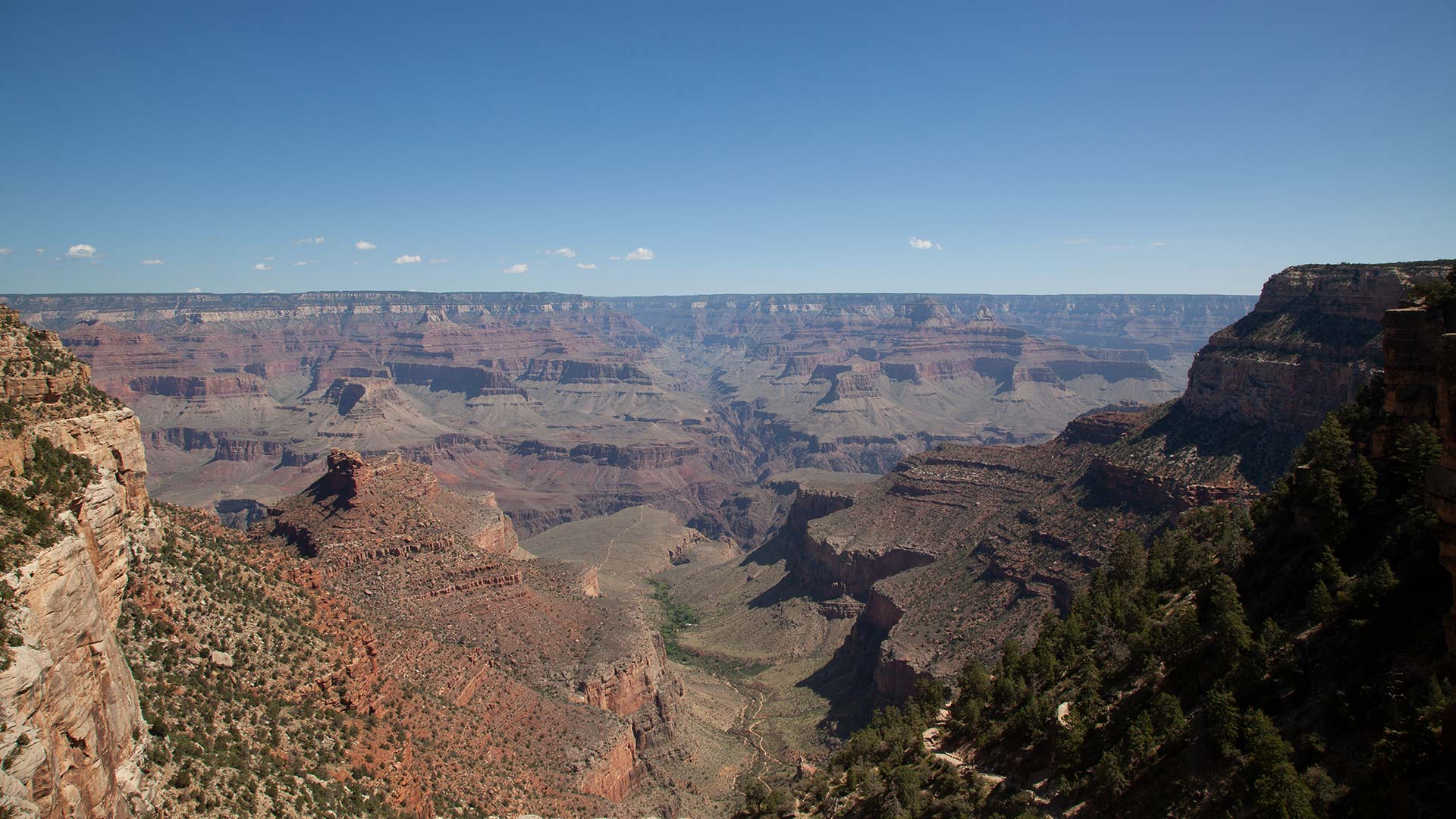 VIEW LARGER Views of Havasupai Gardens from the top of Bright Angel Trail at Grand Canyon National Park, Thursday, Aug. 31. In 1928, the National Park Service instituted policies that forced the Havasupai Tribe out from Ha'a Gyoh, the vibrant riparian area close to the Colorado River in the inner canyon where they once lived. Colloquially and offensively, known as "Indian Gardens," it wasn’t until last year, that the National Park Service on behalf of the Havasupai Tribe, submitted a letter to the U.S. Board of Geographic Names, to change the name to Havasupai Gardens.
VIEW LARGER Views of Havasupai Gardens from the top of Bright Angel Trail at Grand Canyon National Park, Thursday, Aug. 31. In 1928, the National Park Service instituted policies that forced the Havasupai Tribe out from Ha'a Gyoh, the vibrant riparian area close to the Colorado River in the inner canyon where they once lived. Colloquially and offensively, known as "Indian Gardens," it wasn’t until last year, that the National Park Service on behalf of the Havasupai Tribe, submitted a letter to the U.S. Board of Geographic Names, to change the name to Havasupai Gardens. KM: Carletta was instrumental in bringing the tribes together. Advocating from a young age, her platform, as she describes it, is about the environment and water, in the Grand Canyon region. This monument’s designation now meant her life’s work was not all for nothing.
It includes deep canyons, creeks and streams that flow into the Colorado River that make up people’s drinking water in the region.
But, for some tribal members, the problem remains as Pinyon Plain Mine, formerly known as Canyon Mine, still stands.
KM: And just a little bit of ways that way is the uranium mine… and you know, it's right next to the sacred lands, is on the sacred lands. How does that make you feel?
DU: For years, like I said, my elders are not here. They fought and fought into the highest courts. And yet they gave permission for this company to keep coming and digging. For me, it's raping the Mother Earth because they have penetrated her skin. And they won't stop. They punctured one of the aquifers. And it's spewing. And they tell us, you know it's okay. It's not okay. It is contaminated.
KM: The Havasupai tribe sought a lengthy legal battle, attempting to bring its closure as far as the United States Supreme Court, but failing and ending with a federal judge ruling in favor of the mine’s operations in 2022.
The mine is allowed to operate, but doesn’t. Since its opening in 1984, the site has not mined a single ounce of uranium ore due to its low commercial price.
CT: So Canyon Mine here, just happens to be grandfathered in even though there are issues of contamination. There’s issues of lack of oversight, and things like that by the state and federal agencies.
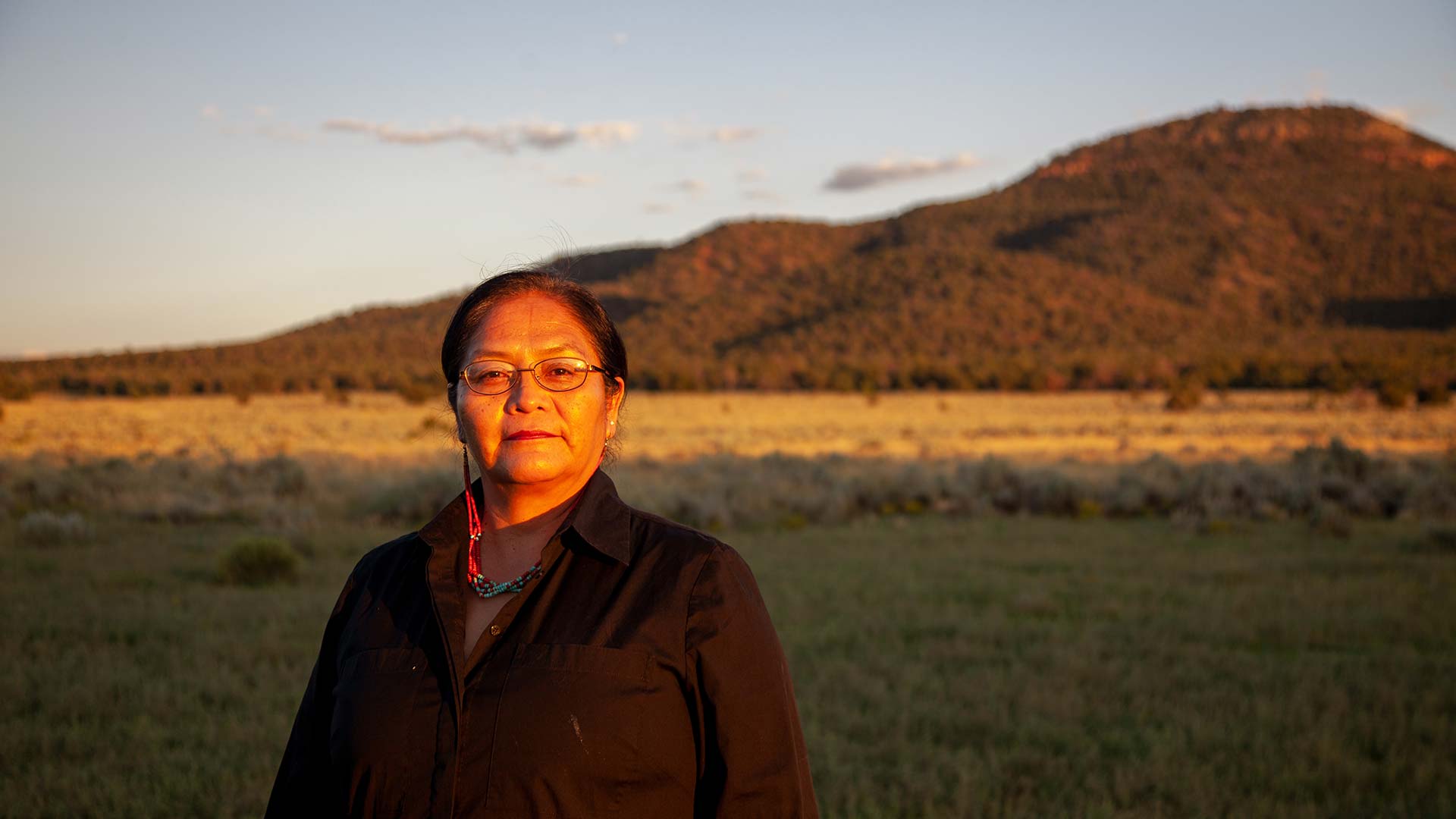 VIEW LARGER Grand Canyon Tribal Coalition Coordinator Carletta Tilousi at Red Butte on Wednesday, Aug. 30. Tilousi has been fighting for environmental justice and sovereignty for the Havasupai Tribe since she was a teenager. She was instrumental in uniting all 22 federally recognized tribes of Arizona, for the historic conservation of nearly one million acres of ancestral land near the Grand Canyon.
VIEW LARGER Grand Canyon Tribal Coalition Coordinator Carletta Tilousi at Red Butte on Wednesday, Aug. 30. Tilousi has been fighting for environmental justice and sovereignty for the Havasupai Tribe since she was a teenager. She was instrumental in uniting all 22 federally recognized tribes of Arizona, for the historic conservation of nearly one million acres of ancestral land near the Grand Canyon. KM: Even with the designation, existing mining claims that predate the 2012 moratorium and two approved mining operations within the monument’s boundaries will not be restricted.
In 2012, under the Obama administration, the Secretary of the Interior Ken Salazar withdrew one million acres, in the Grand Canyon region, subsequently blocking any new uranium mining claims.
Around that time is when Research Hydrologist for the United States Geological Survey Fred Tillman’s current work began.
He works at the Arizona Water Science Center at the University of Arizona. He investigates potential changes in groundwater recharge throughout the Colorado River Basin.
Tillman says as a response to the withdrawal, the Geological Survey was asked by the Department of Interior to look at the potential effects of uranium mining on regional water sources in the Grand Canyon area.
FT: Our studies up there showed that there really wasn’t a widespread contamination from existing mines.”
KM: To be exact, their 2021 study in the Grand Canyon Region said that nearly 95% of samples collected over 40 years showed uranium concentrations below the federal maximum drinking water standard.
For Amber Reimondo, the Energy Director for the Grand Canyon Trust, she believes the Geological Survey’s findings can be and have been misinterpreted by those who have a stake in the industry.
AR: That study absolutely cannot say, and it does not say and the researchers who conducted it wouldn't tell you that it said that uranium mining has caused no harm in the region. All it does is show that at a specific point in time, at these specific water sources, this is what water quality looked like. But that's all it can say, because we don't understand how the systems are interconnected, how fast groundwater flows and from where. And so without that information, you can't say that any of those sites were connected to a mining site. And that is where science gets twisted by the mining industry, which saw that saw that report, and thought it would be a perfect opportunity to take advantage of the the lack of specific understanding within the public and say, This study shows that uranium mining is safe and that there hasn't been any problems and that therefore, we should be able to continue going forward. Like they just completely twisted what the, what the study was even capable of doing.
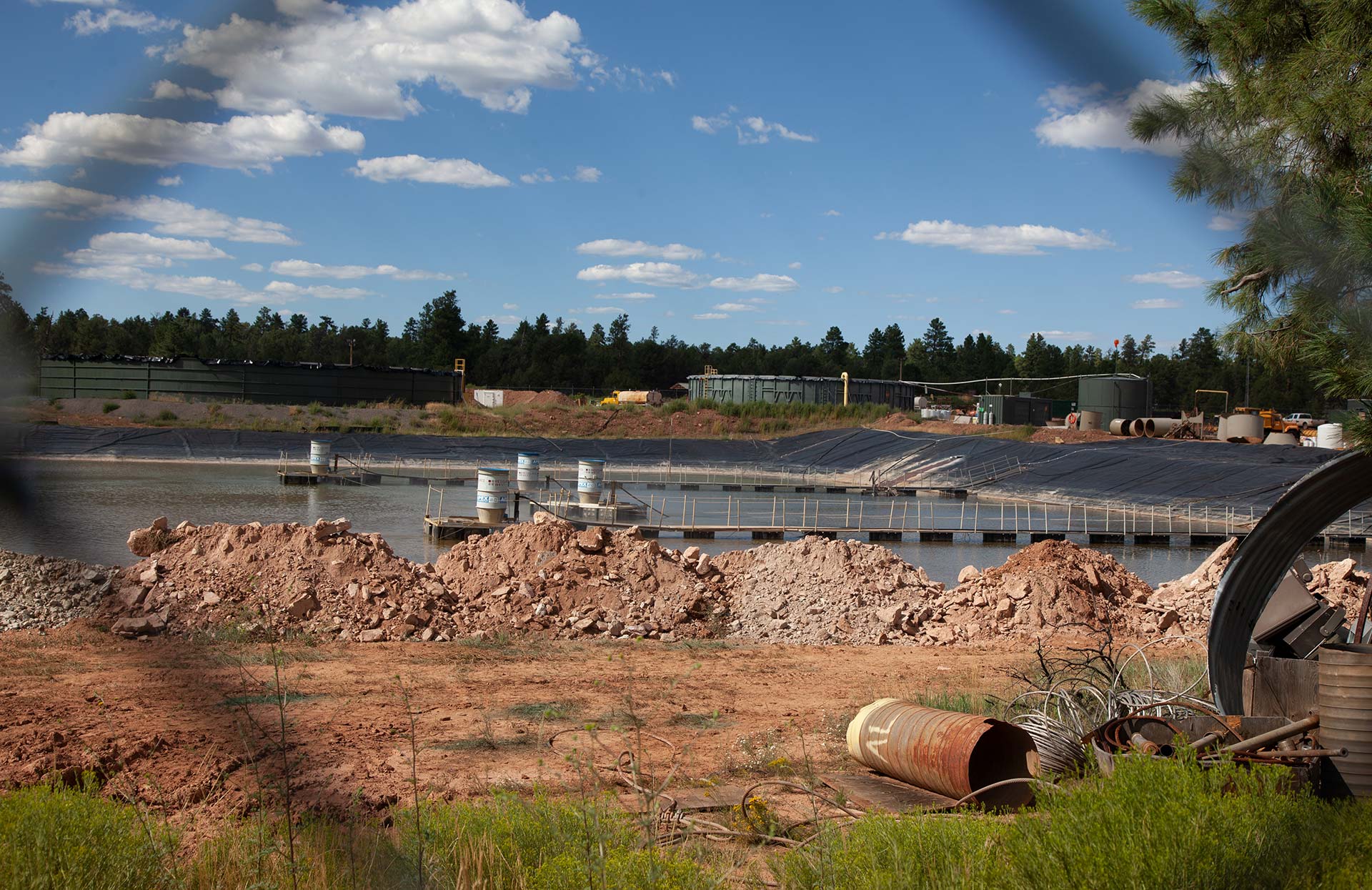 VIEW LARGER Containment pond at Pinyon Plain Mine in Coconino County on Wednesday, Aug. 30. The containment pond is lined with impermeable pond liner that protects the ground from potential contamination
VIEW LARGER Containment pond at Pinyon Plain Mine in Coconino County on Wednesday, Aug. 30. The containment pond is lined with impermeable pond liner that protects the ground from potential contamination KM: When the study was released in 2021, Energy Fuels told Flagstaff NPR-affiliate KNAU that “the report confirms their stance that modern uranium mining is low impact, and doesn’t contaminate groundwater.”
While the study says there is no widespread contamination, Tillman emphasized that this was more than just a single question to be answered.
FT: “It's a two part question. We may not have found anything that indicates widespread contamination, but the flow path, particularly with groundwater area so slow up there, that it could be if there were contamination from the mine, it just hasn’t reached one of the springs that we’ve sampled or one of the wells that we had access to. So it’s one of those cases where it’s very difficult to prove the absence of something, it could just be that it’s on its way and we just weren’t monitoring long enough yet.
KM: The groundwater network in the Grand Canyon region is expansive beneath the surface, and has yet to be fully understood.
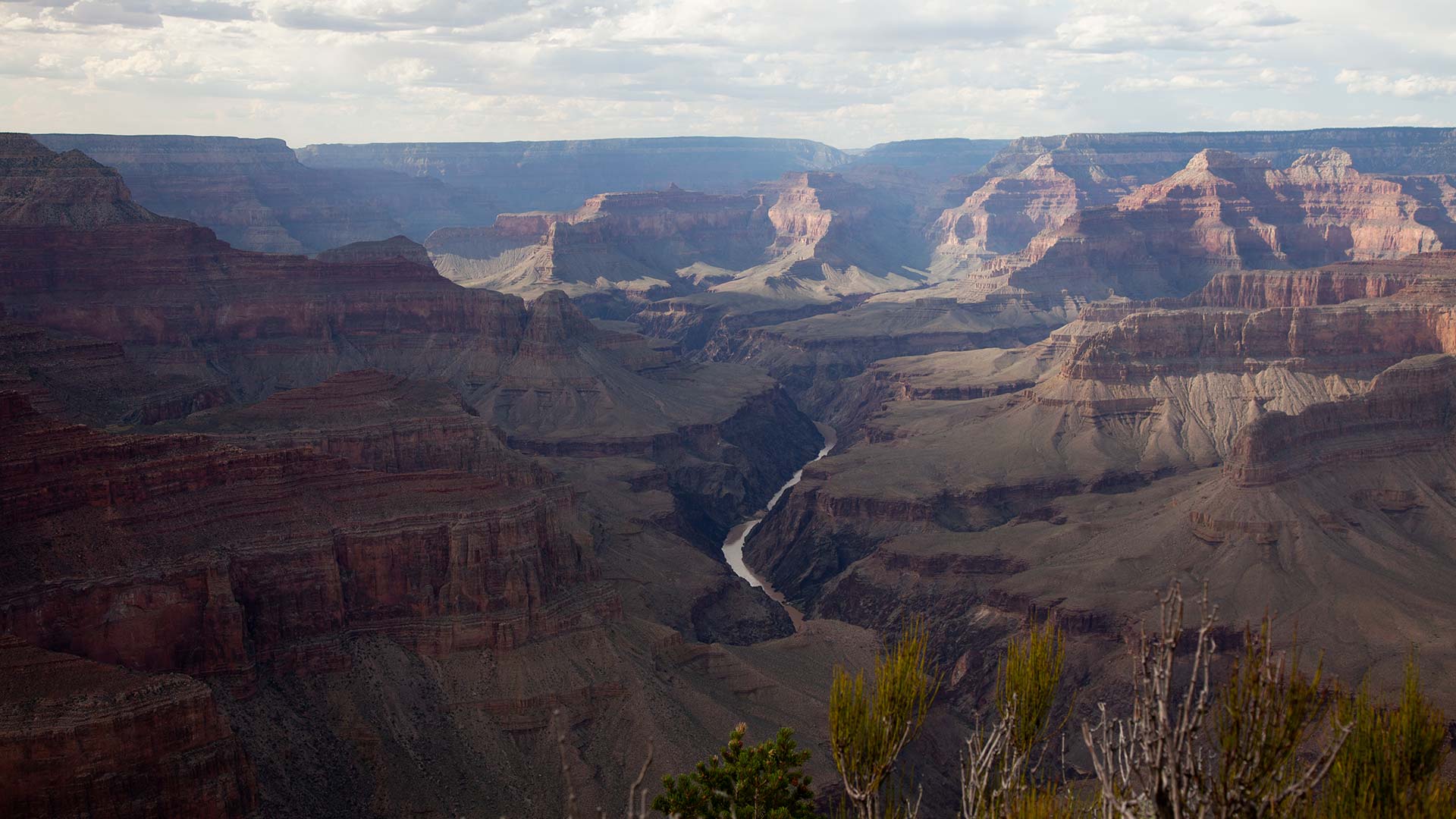 VIEW LARGER The Colorado River in Grand Canyon National Park on Thursday, Aug. 31. 3% of the Colorado River's base flow comes from perennial springs throughout the its watershed.
VIEW LARGER The Colorado River in Grand Canyon National Park on Thursday, Aug. 31. 3% of the Colorado River's base flow comes from perennial springs throughout the its watershed. Hydrologist at Grand Canyon National Park, Hannah Chambless says there’s hundreds of known springs throughout the park. Possibly thousands.
HC: Many of these springs are sacred to the 11 traditionally associated indigenous tribes and they provide critical drinking water for backcountry hikers and wildlife and the park’s only water supply is from one spring, Roaring Springs.
KM: The aquifer system is made up of two main aquifers, both of which are hosted in limestone and sandstone. The first and more shallow aquifer is the Coconino Aquifer, which sits at about 1000 feet below the surface. Beneath several rock layers in the terrain, is the deeper Redwall Muav Aquifer.
The rock layers in between the two aquifers do not transmit water well– rather, most of the water that travels from the surface to the shallow Coconino, makes its way through faults and fractures.
Most of the large springs that can be seen throughout the canyon, originate from the deeper, Redwall Muav.
In their attempt to reach high-grade uranium ore, Energy Fuels continued drilling, piercing the Coconino in 2016. Now, Reimondo, along with environmental groups like the Sierra Club and Center for Biological Diversity say it's been flooding with millions of gallons of water each year.
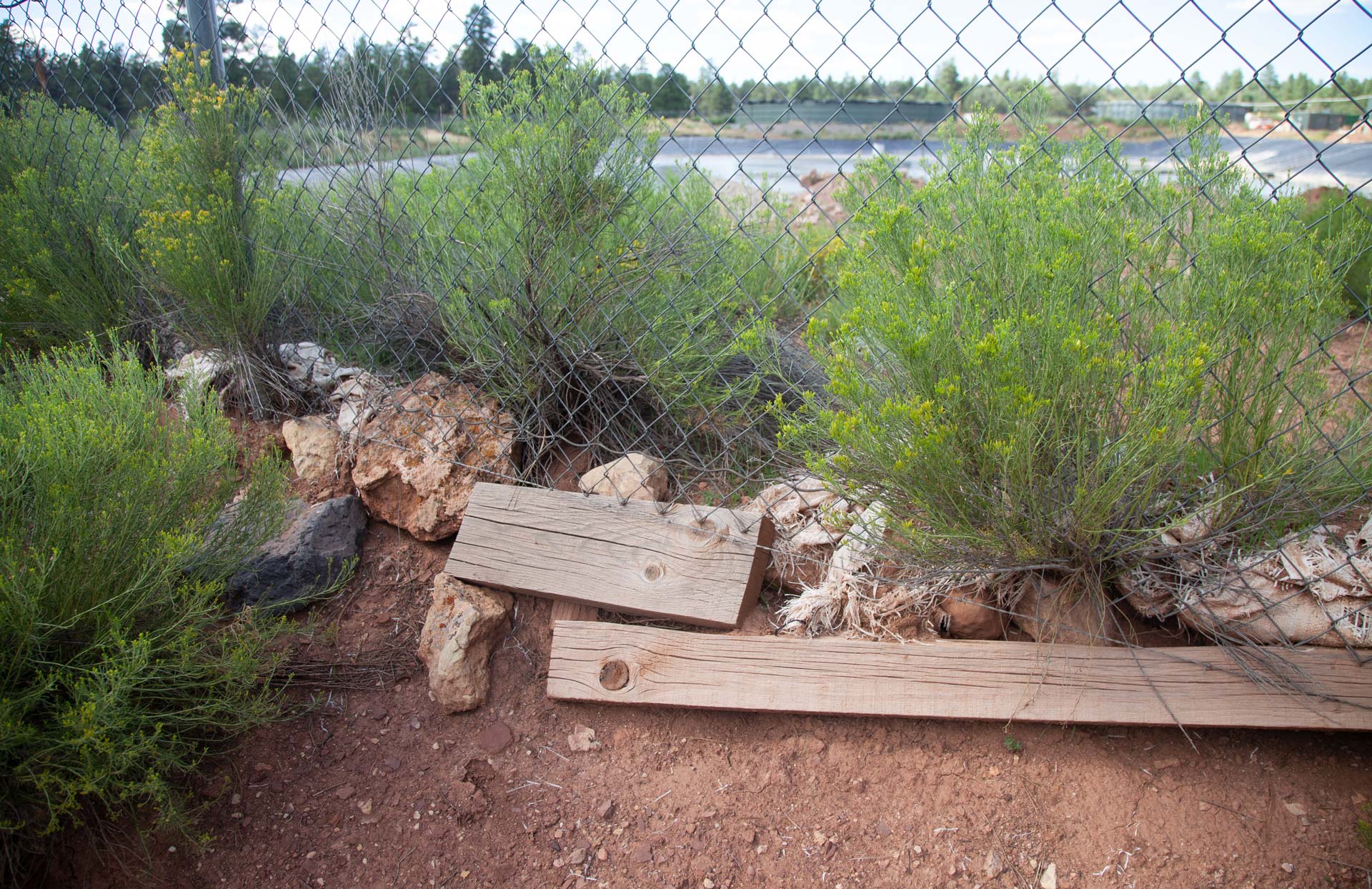 VIEW LARGER The fence that surrounds Pinyon Plain Mine in Coconino County, on Wednesday, Aug. 30. Wooden planks serve as short-term fixes in preventing small animals from entering the mine, potentially falling into the containment pond.
VIEW LARGER The fence that surrounds Pinyon Plain Mine in Coconino County, on Wednesday, Aug. 30. Wooden planks serve as short-term fixes in preventing small animals from entering the mine, potentially falling into the containment pond. AR: When that water flows into the mineshaft and comes into contact with the uranium ore that they've exposed to oxygen and water, now water, it becomes contaminated with things like uranium and arsenic.
KM: According to an Energy Fuels’ technical report, perched groundwater is seeping into the shaft at a rate of approximately 16 gallons per minute. That means over eight million gallons of water per year flood into the mine that must be collected and separated due to uranium and arsenic contaminants.
AR: So that groundwater has to be carefully managed, it has to be pumped out, put into an on-site wastewater impoundment, and it can't be allowed to percolate down into the ground.
 VIEW LARGER Water evaporators at Pinyon Plain Mine in Coconino County on Wednesday, Aug. 30. In 2016, Energy Fuels Inc. pierced the Coconino Aquifer, which caused potentially contaminated water to flood the mineshaft. The water is dewatered, or evaporated as it continually floods.
VIEW LARGER Water evaporators at Pinyon Plain Mine in Coconino County on Wednesday, Aug. 30. In 2016, Energy Fuels Inc. pierced the Coconino Aquifer, which caused potentially contaminated water to flood the mineshaft. The water is dewatered, or evaporated as it continually floods. KM: That process is known as dewatering. Reimondo believes that, given the drought and groundwater systems, this type of containment is risky and irresponsible.
But, Arizona’s Department of Environmental Quality disagrees. In the 2022 individual aquifer protection permit, the agency says that the natural hydrogeologic protections at the mine, like the absence of large faults or fractures, are expected to prevent any potential impacts to groundwater from mining operations.
That same permit says that the bottom of the mine’s operations will be separated from the deeper Redwall Muav by at least 500 feet of a nearly impermeable rock formation known as a breccia pipe. The breccia pipe would also prevent any potential groundwater contamination that comes from site operations.
The reality is the structures around Pinyon Plain are different from other mining sites.
FT: There’s been about five to seven mines over the decades up there in that area and it’s a particular kind of mine it’s called a breccia pipe uranium mine so it’s nothing at all like uranium mining on Navajo land.
KM: Breccia pipes, the way Tillman describes it, are kind of like chimney structures. In the Grand Canyon region, the uranium ore sits in the breccia pipes that aren’t at surface level but instead several thousand feet down.
Once the ore is mined, it is shipped off to Blanding, Utah.
That is where the only fully licensed and operating conventional uranium mill in the United States is located. It’s owned and operated by Energy Fuels–the same company that owns Pinyon Plain mine.
FT: There were a few areas, one near Orphan Mine, which is on the South rim of the Grand Canyon in the national park that had really high uranium concentrations and we’re still doing some studies to sort of tie that into that particular mine there.
KM: But the studies were unable to associate the findings directly with uranium mining in the area.
While tribes are voicing concerns over uranium contamination, Tillman says “other elements commonly associated with these uranium deposits may pose a greater risk to human populations in the area.”
The Geological Survey released a study this year illustrating high arsenic concentrations in groundwater in that area. Tillman says arsenic is a naturally occurring element in Arizona and the southwest.
He hypothesized that “potential effects from mining activities on groundwater would likely first be observed in the shallow system closest to the mine shaft and ore deposits…” if that were to happen.
In that same report, the Geological Survey says as long as water doesn’t accumulate in the mine shaft, and the containment pond liner remains impermeable, groundwater contamination is unlikely.
…
KM: Those who live in Arizona understand the complexities and controversies that surround groundwater management, especially when it comes to the intersection of tribal rights and economic development.
President Joe Biden’s designation has since gained criticism from Arizona’s top Republican lawmakers, like Senate President Warren Petersen.
WP: This is not how government should function within Arizona or the United States. Frankly, we don't need or want the federal government coming in and dictating to Arizonans how to protect Arizona. We know better than Washington, what is best for our lands and our citizens.
KM: Republican lawmakers in the state voted to oppose the monument calling it a dictator-style land grab, saying it will hurt the economy and devastate industries like mining.
(pensive music fades in)
But, the recent landmark designation in the homelands of the Havasupai marks the beginning of a new chapter, of a story that predates westward expansion.
For elders like Dianna Uqualla, this movement is just one step closer towards sovereignty and self-determination.
DU: To stand here, and know that my elders were here. And they cried, they prayed, they danced, because they wanted this place to be strong still in our way. And they left all this here for us. I hear their voices. And they're really happy to know this is finally going to be protected…So for them, I celebrate every night in my prayers. In my waking, I prayer. I say, thank you for giving us the courage to stand up because it wasn't easy. It wasn't easy to bring all the tribes together to be one voice. My elder, the last one that left he know, I knew and we said yeah, we know what we have to do, we have to bring them together and do it as one voice…I know they're just in a place that they're really happy for us. But like I said, he said to me, I'm not going to be here to see the victory. But you will, you will see the victory. And he said that to me. And it was it came true. I'm here and I see it. And for them, I am so happy and beyond words.
 VIEW LARGER Dianna Uqualla and Carletta Tilousi at Red Butte on Wednesday, Aug. 30. Both Havasupai woman have fought for conservation and acknowledgement for their tribe since they were young.
VIEW LARGER Dianna Uqualla and Carletta Tilousi at Red Butte on Wednesday, Aug. 30. Both Havasupai woman have fought for conservation and acknowledgement for their tribe since they were young. ZZ: AZPM News reached out to Energy Fuels, Incorporated for an interview. After talking with their spokesperson, the mining company declined our request for comment. In their email, the company said they have “experienced reporting from multiple NPR affiliates that is unbalanced, misleading and omits well-established facts that support the company’s position.” AZPM News asked for access to studies that support those facts. We did not receive an immediate response.
(theme music fades in)
The question still remains though…does following the letter of the law adhere to the spirit of the law? And how do rules and regulations affect whether mines like Pinyon Plain get approval?
That's next week.
Tapped is a production of AZPM News.
This episode was written, produced and mixed by Katya Mendoza and Paola Rodriguez, with editing help by me, Zac Ziegler.
Our theme music is by Michael Greenwald.
Visit our website in the podcast section of azpm.org for pictures, links and more. Thanks for listening.
(theme music fades out)
This episode of Tapped was supported by a grant from The Water Desk, an independent journalism initiative based at the University of Colorado Boulder's Center for Environmental Journalism.
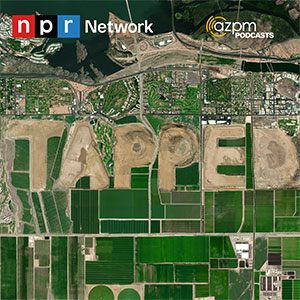







By submitting your comments, you hereby give AZPM the right to post your comments and potentially use them in any other form of media operated by this institution.